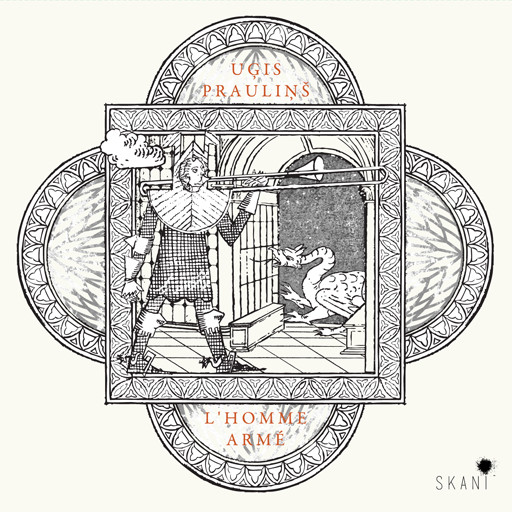Latvian composer Uģis Prauliņš has long been known for his diverse and striking compositions, which often combine both modern and ancient elements, such as Renaissance and Gregorian styles. One of his best-known works, the oratorio Odi et Amo, a recording of which was released in 1999, featured the Riga Cathedral Boys’ Choir alongside synthesizers and electric guitars.
Prauliņš continues to explore the sounds and styles of different eras, combining them in new and intriguing way. A more recent composition, the Mass and Interludes L’homme armé, was recorded by the ancient music ensemble Ars Antiqua Riga (a vocal ensemble with five members, including artistic director Pēteris Vaickovskis), and was released by the Latvian national record company Skani in 2022.
The work, which combines elements of the traditional Christian mass, as well as songs and texts about war and peace, was partially inspired by the French knight’s song L’homme armé, and also grew from a collaboration between Prauliņš and Vaickovskis, who invited the composer to write interludes on Franco-Flemish Renaissance era composer Johannes Ockeghem’s Mass L’homme armé.
L’homme armé uses less of the modern elements than Odi et Amo did, though the composer himself does perform the synthesizer on some of the tracks, such as the subdued and dreamy introduction ‘Introit’. Though the text is about how the “armed man should be feared”, the work has a meditative nature, in contrast to the text about battle.
Prauliņš offers an authentic Gregorian style interpretation of the traditional ‘Kyrie’ section of the Mass, a work of sublime beauty, with the individual voices of the members of Ars Antiqua Riga rising and falling in harmony with each other, supplemented by the sounds of the sackbut (an ancient version of the trombone) performed by Vairis Nartišs and Kaspars Majors.
The album was recorded at St. John’s Church in Riga, and one of the many benefits of the recording location is that the church organ, here played by Jānis Pelše, can be used throughout the performances, both with the singers, as well as individual instrumental works like ‘Manzarek M. Monk’ and ‘Trouvére’.
Though most of the work is meditative and contemplative, there are lively and powerful moments, such as the almost bellicose ‘Perc. Org. Shuffle’, which brings forth the battle elements of the text. The voices of Ars Antiqua Riga also give Prauliņš’ ‘Gloria’ a triumphant air, with their resounding performance of the text ‘Gloria in excelsis Deo’, which then leads to the celebratory ‘Hosanna in Excelsis’ and its repeated, exultant ‘Hallelujah’.
There are also moments of tension, particularly in the almost abrasive ‘Dies irae’, where Prauliņš’ music accentuates the fear and terror in the text, and this is further enhanced by the dramatic and energetic organ performance by Pelše, along with the ominous sounds of the sackbuts.
Though firmly rooted in the Renaissance era, Uģis Prauliņš L’homme armé adds a few modern touches to make for an immersive and atmospheric listen. Aided by the immense vocal talents of Ars Antiqua Riga and their artistic director Pēteris Vaickovskis, along with skilled organist Jānis Pelše and sackbut players Vairis Nartišs and Kaspars Majors, the work proves to be an inspiring and moving prayer for peace.
Egils Kaljo
19/10/2023, www.latviansonline.com
__________________________
Born in Riga in 1957, Uģis Prauliņš is one of Latvia best-known contemporary composers, along with Pēteris Vasks (*1946). Prauliņš became famous above all for his Missa Rigensis, which was premiered in Riga Cathedral in 2003. "Mass and Interludes "L'Homme Armé", the full album title, premiered in 2020. The work was the result of a creative symbiosis between Prauliņš and conductor Pēteris Vaickovskis, who initially invited the composer to write musical commentaries (interludes) on Johannes Ockeghem (c. 1414–1497) mass "L'Homme Armé". The collaboration offered Prauliņš the opportunity to expand the interludes into a mass. The five singers (countertenor, two tenors, baritone, bass) are accompanied by an organ, two sackbuts (a type of medieval trombone) and electronic instruments. The album, which has now been released on the Latvian label Skani, leaves a somewhat ambivalent impression (on me). First the positive: the CD sounds fantastic, and the music gives the impression that it was composed precisely for this medium with its surround sounds and electronic effects (bringing the work live on stage like this certainly requires great effort). The five singers of Ars Antiqua Riga perform magnificently in every respect, but they show their full ability almost more in the quieter a cappella parts of the work, such as in the Agnus Dei, than in the louder passages accompanied by instruments. In other words, this album is a pure feast for the ears, especially since the music has been washed in just about all the waters that music history - from the Renaissance to today - has to offer. However, in combination with the enormous claim that the work makes in Ockeghem slipstream, its eclecticism has a whiff of arts and crafts to my ears. Surely Prauliņš means it when he speaks in the preface to the booklet that we humans are given the choice "between good and evil, life and death, white and black, love and hate". Whether the music lives up to this, however, is a question mark.
Ensemble sound: *****
Interpretation: ****
Burkhard Schäfer
Chorzeit, 05/2023
__________________________
One of the most frequently quoted melodies in Renaissance history, L’homme armé is a secular song from the Late Middle Ages used in over 40 separate settings of the Ordinary of the Mass. Two masses by Josquin, as well as compositions by Pierre de la Rue, Guillaume Du Fay, Palestrina and other luminaries of the time, have ensured that L’homme armé continues to be remembered and recognized by audiences and aficionados even today.
Rather than simply being an artifact from the past, composers still use this melody in their works, as demonstrated in Ars Antiqua Riga’s recent release of Uģis Prauliņš’ L’homme armé, a time-bending journey through plainchant, Renaissance-style polyphony and modernism. Instead of trying to simply reimagine the historical sounds and styles of previous composers, Prauliņš integrates this immediately recognizable tune into his own inimitable style, incorporating organ, sackbut and electronic instruments to great effect.
To say that Prauliņš’ L’homme armé is a revelation is an understatement, especially when one considers that this work is structured around the Ordinary of the Mass. Unlike Renaissance settings which were restrained by the required inclusion of certain movements, Prauliņš expands the standard structure of the Mass, incorporating additional texts to overcome both the dramatic and temporal limitations of the traditional form.
While much of Prauliņš’ music is “atmospheric,” the aural impact of L’homme armé is stunningly indescribable, and there is not enough space in this review to include a suitable number of superlatives. Ars Antiqua Riga and its director Pēteris Vaickovskis give an extraordinary performance; a treasure for all who appreciate choral music executed at the highest level.
Matthew Whitfield
15 December, 2022
www.thewholenote.com
__________________________
Latvian composer Uģis Prauliņš is one of those eclectic postmodern voices who are happy to ignore boundaries of musical genre and historical period, exploring and combining styles ranging from Renaissance polyphony to contemporary rock music. In this regard he was a perfect choice for conductor Pēteris Vaickovskis, whose original invitation was for musical interludes to go with Johannes Ockeghem’s Mass L’homme armé. This sort of thing has been done before, for instance with Paul Hillier and Bengt Sørensen with Ockeghem's Missa pro defuncti, but Prauliņš has taken the process a few steps further in the present production, expanding his interludes to create a new Mass in its own right.
The Mass and Interludes L’homme armé were written for five-voice vocal ensemble Ars Antiqua Riga, alongside organ and sackbuts to enhance the ‘period’ feel, and also involving electronic instruments to create atmospheric soundscapes at certain points in the work.
I'm normally a big sucker for this kind of blend of ancient and modern, and the ASMR-stimulating beauty of the electronics that underly the Introit filled me with hope and interest, despite a rather 1970s keyboard sound. In short, there are good things in L'homme armé, but these good things are too thin to sustain a rather ragged set of 23 tracks over 70 minutes. The familiar ‘l'homme armé’ tune pops up from time as you would expect, and the Kyrie is an encouraging variation on period style. The shorter movements that sound as if they are part of the original collection of interludes work nicely, and the touch of Arvo Pärt in the Absolution embellished with electronics is harmless. Heavy-footed textures plague the music elsewhere however, with the recording sounding as if it has been set at too high a level in places. Some sections have an elemental Carl Orff feel but without his rhythmic bounce, others set up nice ideas that undercut themselves out of duty to the Mass concept, and some just emerge and lie there without much to say at all. Much of the singing is of necessity or design rather shouty and unappealing, the attempt at times to put the voices on the same level as organ and sackbuts not recommendable.
Having lost patience before even reaching halfway with this recording, I had to ask myself why this is the case. There is an element of the theatrical with a good Mass setting, and this work goes some way towards attempting this quality. Without a sense of inevitable flow between moments and of dramatic or emotional climax there is, however, a permanent pall of frustration over the whole project. Harmonic development over the whole is lacking. This is probably another side effect of duty towards period but a missed opportunity to my ears, but you come away with a Scelsi-like impression of a grand work based around a single note. Points of sensitive reflection such as the Beati pauperes are isolated and a bit bland, here again the moment vanishing in medieval meandering and a Swingle Singers 'dum dummm’ conclusion that just has me thinking ‘come on, surely we can do better than this...’
There are some beautiful moments to be found. Pater sanctificetur opens well, but as with most of this music, kicks itself in the heel and falls over all too soon with its ‘oom pah’ organ. The best of the music here is relatively unexplored, being all too keen to grow swiftly into something grand and overly baggy. The Agnus Dei has some true expressive value but doesn't quite hit the spot, and by now we're too worn out by what has gone before - it's too little too late.
The message for this work is laudable: “The Mass and Interludes L’homme armé are about each individual struggles, which often grow into common struggles for all, with victories and defeats, moments of strength and weakness, yet always with an endless desire for peace.” At about 30 minutes shorter and only developing its best ideas this might have been magnificent. As it is, this is an edifice that is unwieldy and annoying, ending up spoiling its vistas rather than enhancing them.
Dominy Clements
November 28, 2022
www.musicweb-international.com

